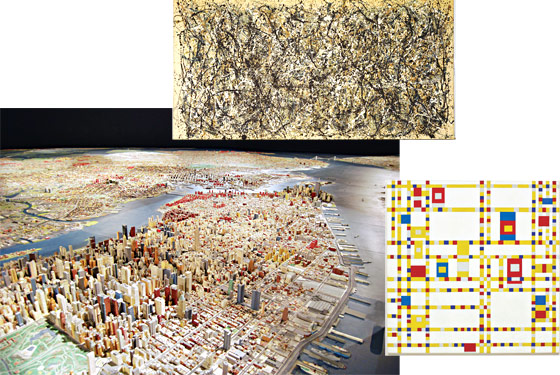
The greatest work of art about New York? The question seems nebulous. The city’s magic and majesty are distilled in the photographs of Alfred Stieglitz and Paul Strand. Jackson Pollock’s One: Number 31, 1950 is an image of what New York felt, looked, and sounded like in 1950. There’s the optical hop of Piet Mondrian’s Broadway Boogie Woogie; the Brooklyn Bridge paintings of Joseph Stella; Willem de Kooning’s sluicing flumes of luscious paint that conjure a writhing New York Babylon. There are endless portraits and pictures of the city’s denizens, old and young, famous and not by Alice Neel, Florine Stettheimer, Irving Penn, Helen Levitt, Berenice Abbott, Robert Mapplethorpe, Diane Arbus, and Andy Warhol.
New York is all of these things, flowing ever outward in decay and growth, ennobled and abject: It can’t be contained by any one artist. De Kooning, the immigrant, and Pollock, the Westerner who went East, give us the juice and flickering quickness but not the solitude, self-delusion, or ideas of order. Neel gives us sodden selves oozing meaning and intensities. But we’re always inside Neel’s frame. What of Stieglitz’s picture of immigrants in steerage? Not all those who came to America by ships came voluntarily. Perhaps Jacob Lawrence’s epic series on black migration from the South at the beginning of the twentieth century? All these broken-whole spirits, always escaping, reinventing, kings and queens of their own worlds, embody aspects of New York.
So let’s get literal. The closest thing to a full-blown portrayal of the city in a work of art that is also a singularity unto itself is called simply The Panorama of the City of New York, housed in the Queens Museum of Art since 1964. This 9,335-square-foot model, a relic from another era made of wood, plastic, fake shrubbery, Formica, and whatnot, is the only way to see the entire city all at once. It is a theatrical cabinet of cartographic curiosities, a topographic dinosaur in the age of Google Earth. (It is also out-of-date: Its last makeover was in 1992.)
Every time I visit, I go into a sort of spaced-out, semiconscious coma. From my God’s vantage point on the walkway that surrounds it, I feel like some all-seeing bodiless eye. I might think about where Walt Whitman stood when he wrote “Crossing Brooklyn Ferry,” look at where the Titanic might have docked had she made it. Often I’m amazed at how little I really know about this city I’ve lived in for 30 years. “What neighborhoods are those?” I wonder.
Optically, the model seems always to be in twilight. Mostly green, red, and gray, the colors, shapes, and forms run together—buildings, bridges, and cloverleafs blur into one. I become hypnotized by a sight no human eye has ever seen: the city stripped down to its perfected built self. The only signs of life are the tiny lights that dim and brighten every twelve minutes, mimicking day and night, and the tiny planes that ride little wires in and out of La Guardia. I find I hate the nights; I feel too alone.
Fittingly, this apocalyptic apparition was commissioned by the great city builder-destroyer, Robert Moses. It gives tangible form to the city that Moses carried in his head, idealized and hygienic. And yet, as I look at the Panorama, I sense what Wallace Stevens meant by how, when twenty people cross a bridge to a city, they’re actually crossing twenty bridges to twenty cities. In the Panorama I no longer see the city: I see my city. I see the crappy apartments and shitty buildings where I’ve lived, the hospitals where I watched a loved one die, the corner where I met my wife, the park where we walked arm in arm for hours one night and fell in love, the different places I made love with different women when I was different people, streets I walked until dawn almost jumping out of my skin with terror about what to do with my life and how to be, neighborhoods I traversed filled with soul-eating envy, the apartment I shrieked in when Bill Buckner blew Mookie Wilson’s ground ball in 1986, the place where my dreams came true, the place I’ll likely be buried. The Panorama brings me to my psychic knees.
The Panorama is also the last place anywhere in New York where the World Trade Center still stands, whole, as it stood in the early morning of September 11. I can also see the corner where I saw the first tower fall and howled out loud. Seeing the buildings again here is uplifting, healing. In this way the Panorama is redemptive, a work with the archaic power to provide spiritual balm, conjure the dead, and restore the soul.